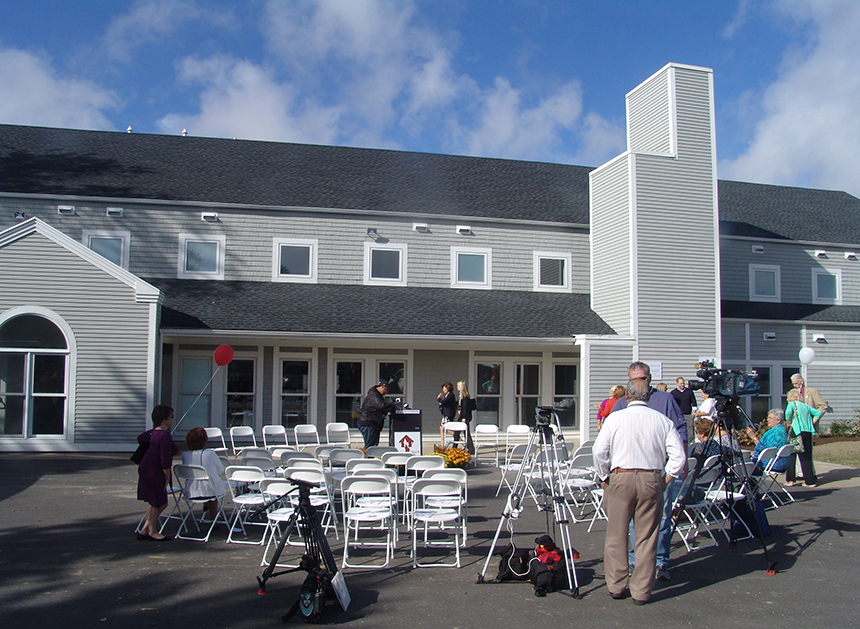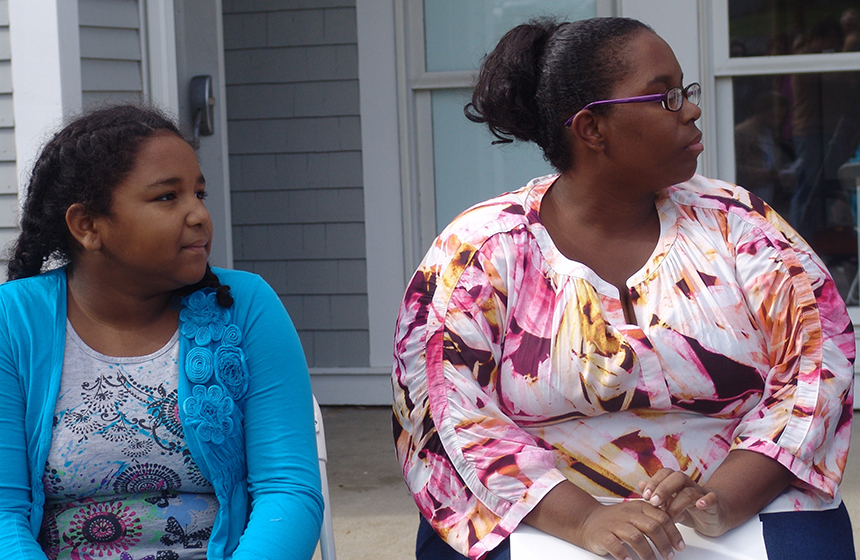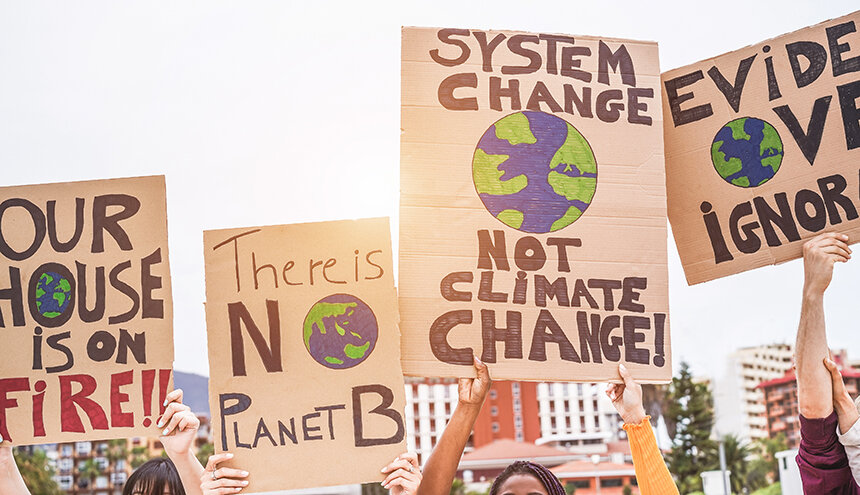There’s No Place Like a Home to Make Life Better
Rhode Island’s collection of shelters and nonprofits work tirelessly to house all those who are homeless
October 29, 2016
MIDDLETOWN, R.I. — Tara D’Ambra showed up at the front door of Lucy’s Hearth’s old facility on West Main Road in 2007, homeless with a 3-year-old by her side. She returned nearly a decade later, with her now-teenage daughter, as the featured speaker at the recent ribbon-cutting ceremony to celebrate the opening of the organization’s new home on Valley Road.
“I was welcomed with warmth and sincerity and caring. … They opened their arms and hearts to me and my daughter,” D’Ambra told the dignitaries, guests and media gathered Oct. 13 in the parking lot of Lucy’s Hearth. “This building here will represent hope. The moms that come here will be able to … have breakfast in the morning with their children.”
The little things are what bring hope back to those left battered and beaten by life. Lucy’s Hearth and many other Rhode Island organizations are working to bring dignity back to those left homeless.
D’Ambra, like most of the homeless women who have turned to Lucy’s Hearth for help during the past 32 years, was dealing with some combination of child-custody issues, legal disputes, unemployment and domestic violence when she arrived. Many who come to Lucy’s Hearth have been living paycheck to paycheck and couch to couch before one final obstacle toppled their house of cards.
Lucy’s Hearth is a nonprofit that provides shelter, counseling, training and critical human services to homeless women and their children. Families remain at Lucy’s Hearth from three to six months, and more than 80 percent transition into permanent housing.
“I am so happy for all the families who get to move into this top-notch facility, happy not because they are homeless but happy because I know they will get the help they need here to transition back into housing, back to their life, back to their community,” D’Ambra said.
The organization’s mission, its director told the gathering, “is working to eradicate family homelessness, and provide families with a safe home, not an institution.”
Jennifer Barrera began her job as Lucy’s Hearth director about the same time D’Ambra and her daughter, Olivia, arrived. “I learned some valuable lessons from both of them,” she said. “The fact they no longer need this facility is wonderful.”
The organization’s new 9,300-square-foot building has 16 one-bedroom units with private bathrooms, large bedroom suites for families, food and clothing pantries, laundry facilities and a computer lab. The nonprofit embraces the universally accepted Housing First model.
“This is what we do for a community,” Rep. Deborah Ruggiero, D-Jamestown, said during the speaking program of the mid-October event. “We’re going to help women and children. We’re going to make sure we help people who need help.”

Housing First works
For the past three-plus decades, basically since Lucy’s Hearth first opened, between 4,000 and 5,000 Rhode Islanders annually spend at least one night on the street or in a shelter. Some have spent years living in a rotation of shelters and being fed by a host of soup kitchens, often taking the bus to get from one to the other.
Last year, for instance, there were 4,263 homeless men, women and children in Rhode Island, according to the Homeless Management Information System (HMIS), which is managed by Maria Cimini of the Rhode Island Coalition for the Homeless and keeps track of the state’s most-vulnerable population. Rhode Island has 482 homeless families and 988 homeless children in 2015.
Despite those discouraging statistics, the number of homeless people in Rhode Island is slowly decreasing, thanks to the continued efforts of organizations such as the Rhode Island Coalition for the Homeless, Amos House, Crossroads Rhode Island and Lucy’s Hearth.
But the waiting list for affordable housing and the state’s typically crowded shelter system is proof of Rhode Island’s continued need. In fiscal 2016, through the services at Lucy’s Hearth, 43 women and 79 children were provided with 9,582 emergency shelter bed nights and 25,653 meals.
“We need a system that doesn’t shelter people but houses them,” Karen Jeffreys, associate director for the Rhode Island Coalition for the Homeless, told ecoRI News in late September. “Shelters have become homes, but the day will come when everyone now in our shelters and living on the street will have a home. We know how to solve homelessness.”
The solution most point to is Housing First — a relatively recent initiative in the efforts to end homelessness. Rather than moving homeless people through different tiers of housing, where each level moves them closer to independent living, this model moves a homeless individual or household quickly from the street or shelter into an apartment.
This approach is based on the concept that a homeless person or family’s primary need is stable housing, and that other issues that may affect the individual or household should be addressed once housing is obtained. In contrast, outdated programs require the homeless to quit their vices before being given a place to live.
“The old way required people to stop drinking or stop smoking,” said LeeAnn Byrne, policy director for the Rhode Island Coalition for the Homeless. “Putting people in houses first works. It provides stability. It gives a homeless person a foundation to build a life on — instead of using the idea of housing as a carrot to stop them from drinking and using drugs.”

Byrne said the old way of placing people in homes had a 30 percent success rate. The success rate of Housing First is 90 percent to 95 percent, she said, noting that figure meshes with the rate of that of the average renter.
On a mission
At a renovated industrial mill in Providence last November, a few days before Rhode Island and the nation celebrated Veterans Day, the ribbon was cut on Veterans for Tomorrow, an affordable housing development on Douglas Avenue.
The development provides housing and access to supportive services for veterans who are homeless or at risk of becoming homeless. The project, partially funded by federal and state historic tax credits, was a major step forward in ending veteran homelessness in Rhode Island.
In 2014, Rhode Island made a commitment to both house all those who are homeless and create a system that is able to quickly house individuals and families who lose housing in the future. Cimini said no individual should be in a shelter for more than 30 days.
The state’s permanent housing commitment was made by signing on to a national movement, the Zero: 2016 campaign. Rhode Island is one of five states and 70 cities/counties participating.
Since the campaign’s launch, 100,000 veterans and chronically homeless individuals nationwide have been placed in permanent housing, according to Cimini. Locally, nearly 800 individuals have been housed, including 365 veterans, she said.
As of Oct. 17, 76 veterans remained homeless in Rhode Island, according to the HMIS database.
The chronically homeless, the group of people currently being addressed in the Zero: 2016 campaign, make up 12 percent to 15 percent of this population but use about 60 percent of the public resources allocated to address homelessness, according to Jeffreys.
Next year, the Rhode Island Coalition for the Homeless will begin to focus more on finding homes for families living in the state’s shelter system. About 40 percent of Rhode Island’s homeless are families, according to Jeffreys. She said 25 percent are children.
Substance abuse, mental-health issues and/or physical disabilities are the main reasons why individuals are chronically homeless, Jeffreys said. For families, she said, it’s more about economics. Lower housing costs and higher wages are two of the best ways to address the problem of homelessness.
Both Jeffreys and Byrne noted that for all of the state’s talk about job creation, Rhode Island’s economic development plan doesn’t address housing. There are Rhode Islanders with jobs who don’t have homes. The state hasn’t put much money into addressing the problem.
In fact, compared to its two southern New England neighbors, the amount of money Rhode Island invests in housing is dismal. In fiscal 2016, Massachusetts spent $99.72 and Connecticut $76.98 on a per capita basis to address housing needs, according to the Rhode Island Coalition for the Homeless. Rhode Island spent $8.46.
The $2.5 million needed to build new Lucy’s Hearth came from 120 donors, including businesses, foundations, trusts and individuals.
Vulnerability risk
The Zero: 2016 campaign and the HMIS database are helping Rhode Island’s collection of shelters and nonprofits house those in the most danger of actually dying first. It’s no longer a first-come, first-served system.
“The higher someone’s vulnerability, the more likely they are going to die on the street,” said Cimini, the campaign’s statewide coordinator. “You don’t focus on the people that are easy to house first. You focus on those who are really in danger.”
Besides keeping track of Rhode Island’s homeless population, the HMIS information managed by Cimini also features a vulnerability index, to let case workers know who needs to be housed immediately. This vulnerability index keeps a detailed record of each homeless individual who has been in contact with outreach volunteers. The information kept includes name, age, veteran status, income, last shelter and notes, and ranks the person on a scale of 1-17 on the vulnerability index, with 17 in most dire need of housing.
As of late October, there were no seventeens on the list, but plenty of sixteens.
“Once we house people, they’re more likely to be successful in dealing with mental illness, physical health, finding a job and getting an education,” Karen Santilli, president and CEO of Crossroads Rhode Island, told ecoRI News during an early-October tour of the organization’s main facility, on Broad Street in Providence. “Not everyone who is homeless is in poverty. Some have income, they just need support. Conversely, there are many people living in poverty who are housed.”
Editor’s note: This is the fourth story in a four-part series looking at homelessness in Rhode Island.
Story 1: Rising Rhode Island Rents Drive Homelessness
Story 2: Low Wages Minimize Rhode Island’s Economy
Story 3: Providence Cemetery Home Turf for Some People Who Can’t Afford to Live




Local artist Sue McNally raffles off two paintings each Christmas to support the Housing Hotline in Newport. $20 per chance and checks are made out to "Housing Hotline". Founded and operated by community police officer Jimmy Winters and his wife, they need all the help they can get after losing a block grant and the homeless rate being higher than ever.
http://suemcnally.com/painting-raffle-2017-